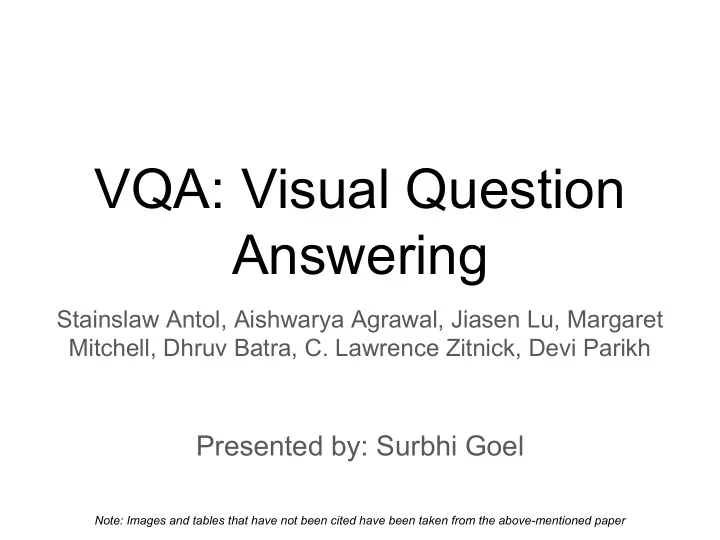

VQA: Visual Question Answering Stainslaw Antol, Aishwarya Agrawal, Jiasen Lu, Margaret Mitchell, Dhruv Batra, C. Lawrence Zitnick, Devi Parikh Presented by: Surbhi Goel Note: Images and tables that have not been cited have been taken from the above-mentioned paper
Outline ● VQA Task ● Importance of VQA ● Dataset Analysis ● Human Accuracy ● Model Comparison for VQA ● Common Sense Knowledge ● Conclusion ● Future Work ● Discussion
Visual Question Answering
Importance of VQA ● Multi modal task - a step towards solving AI ● Allows automatic quantitative evaluation ● Useful applications eg. answer questions asked by visually-impaired users Image credits: Dhruv Batra
Dataset Stump a smart robot! ● >250K images ○ 200K from MS COCO Ask a question that a human can ■ 80 train / 40 val / 80 test answer, ○ 50K from Abstract ● QAs but a smart robot probably can’t! ○ 3 questions/image ○ 10 answers/question ● Mechanical Turk ■ +3 answers/question ● >10,000 Turkers without showing the image ● >41,000 Human Hours ● >760K questions ● ~10M answers ○ will grow over the years 4.7 Human Years! 20.61 Person-Job-Years! Slide credits: Dhruv Batra
Questions
Questions what is
Answers ● 38.4% of questions are binary yes/no ○ 39.3% for abstract scenes ● 98.97% questions have answers <= 3 words ○ 23k unique 1 word answers ● Two evaluation formats: ○ Open answer ■ Input = question ○ Multiple choice ■ Input = question + 18 answer options ■ Options = correct / plausible / popular / random answers Slide credits: Dhruv Batra
Answers Slide credits: Dhruv Batra
Answers Slide credits: Dhruv Batra
Answers
Human Accuracy
VQA Model Neural Network Embedding Image Softmax 1k output over top K answers units Convolution Layer Pooling Layer Convolution Layer Pooling Layer Fully-Connected MLP + Non-Linearity + Non-Linearity what 0 Question Embedding (BoW) where0 how 1 is 0 “How many horses are in this image?” Beginning of could 0 question words are 0 … are 1 … horse 1 … image1 Slide credits: Dhruv Batra
VQA Model Neural Network Embedding Image Softmax 1k output over top K answers units Convolution Layer Pooling Layer Convolution Layer Pooling Layer Fully-Connected MLP + Non-Linearity + Non-Linearity Question Embedding (LSTM) “How many horses are in this image?” Slide credits: Dhruv Batra
Baseline #1 - Language-alone Neural Network Embedding Image Softmax 1k output over top K answers units Convolution Layer Pooling Layer Convolution Layer Pooling Layer Fully-Connected MLP + Non-Linearity + Non-Linearity Question Embedding (LSTM) “How many horses are in this image?” Slide credits: Dhruv Batra
Baseline #2 - Vision-alone Neural Network Embedding Image Softmax 1k output over top K answers units Convolution Layer Pooling Layer Convolution Layer Pooling Layer Fully-Connected MLP + Non-Linearity + Non-Linearity Question Embedding (LSTM) “How many horses are in this image?” Slide credits: Dhruv Batra (C) Dhruv Batra
Results
Challenge: Common Sense Does the person have perfect vision?
Evaluate Common Sense in the Dataset Asked users: ● Does the question require common sense? ● How old should a person be to answer the question? Image credits: Dhruv Batra
Evaluate Common Sense in the Dataset Asked users: ● Does the question require common sense? ● How old should a person be to answer the question? Image credits: Dhruv Batra
Conclusion ● Compelling ‘AI-complete’ task ● Combines a range of vision problems in one, such as ○ Scene Recognition ○ Object Recognition ○ Object Localization ○ Knowledge-base Reasoning ○ Commonsense ● Far from achieving human levels
Future Work ● Dataset ○ Extend the dataset ○ Create task-specific datasets eg. visually-impaired ● Model ○ Exploit more image related information ○ Identify the task and then use existing systems Challenge and workshop to promote systematic research (www.visualqa.org)
Discussion Points (Piazza) ● Should a different evaluation metric (such as METEOR) be used? ● How to collect questions faster (compared to humans)? ● Is the length restriction on the answers limiting the scope of the task? ● Since distribution of question types is skew, will it bias a statistical learner to answer only certain types of questions? ● Why use ‘realistic’ abstract scenes for the task? ● Why does LSTM not perform well? ● Would using Question + Image + Caption give better results than using Question + Image ? ● Should we focus on task specific VQA?
Thank You!
Recommend
More recommend